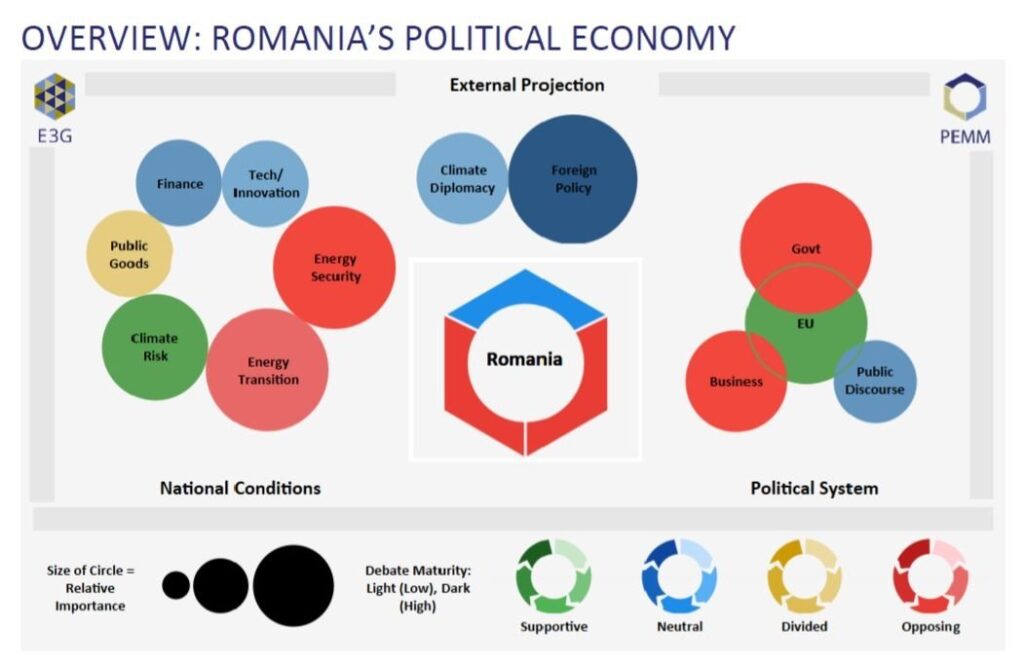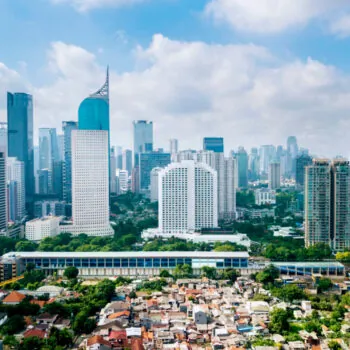E3G’s Political Economy Mapping Methodology (PEMM) assesses threats and opportunities to countries presented by the low-carbon transition.
PEMM aims to identify underlying tensions across national conditions, political system and external projection to determine what constructs a country’s core national interest and to identify key interventions which could help to increase domestic climate ambition and enable progress on the low-carbon transition. PEMM is based on desk-based research, expert interviews and in-country testing.
Our assessment of Romania shows clearly that many aspects of the country’s political economy stand in opposition to a low-carbon transition. In all three headline categories of our analysis – national conditions, political system, and external projection and choice – we conclude that most factors actively oppose the transition. Nevertheless, we have identified several access points for an accelerated low-carbon transition in Romania:
National Conditions
Overall, the national conditions oppose an accelerated low-carbon transition. Fossil fuels play an important role in Romania’s energy mix and further fossil fuel and nuclear capacity are planned. Coal accounts for roughly a third of the electricity mix and enjoys strong political support. The country also has significant gas and oil resources, making it one of Europe’s most energy-independent countries.
Despite high economic pressure on coal, Romania has not yet defined a phase-out date or a Just Transition strategy. After a support scheme for renewables had fostered growth, it has since been terminated and new regulatory roadblocks have de facto ended the development of renewable technologies. Renewable sources, mostly hydro power, account for roughly 40% of the energy mix today.
Within the realm of energy politics and policy, inefficient energy infrastructure and energy poverty are key issues for the country, next to maintaining energy independence from Russia. In fact, Romania is one of the European countries with a very low energy dependency rate and it is set to play a major role in the European oil and gas market due to recent discoveries in the Black Sea if the necessary policy frameworks are created. There is also large potential for additional wind and solar capacity across the country.
Potential drivers of the low-carbon transition such as technology, innovation, finance and the perception and role of public goods are not yet playing a significant role in Romania’s transition. The country is an attractive outsourcing destination for information and communication technologies (ICT) development and the quality of its higher education in technical fields is notable.
However, low public and private investments in research and development (R&D), brain drain, emigration and a lack of skilled workforce in many areas are key challenges for further technological development. The boom in renewables has shown that Romania could benefit from active engagement in low-carbon supply chains, but this would require targeted public investment. Although Romania has seen a lasting period of rapid growth, this was almost entirely driven by private consumption enabled through generous social spending and public investments into a low-carbon transition depend largely on the EU budget.
Due to high poverty and increasing income inequality, economic issues are perceived as a key challenge for the country by the public, whereas climate change or environmental issues are not of foremost concern. Romania is the EU country most vulnerable to natural disasters and it faces high economic costs from extreme weather events, such as floods and droughts, but these are not connected to climate change in the public discussion.
Political System
In general, key actors and institutions of the political system oppose an accelerated low-carbon transition. Government and businesses tend to support incumbent high-carbon industries. Romanian politics is dominated by the social-democratic PSD, which is the country’s largest party and has close ties to the country’s coal regions. Overall, trust in domestic political institutions is relatively low, and corruption is identified as a systemic challenge. Close ties between politics and the energy industry, in combination with unstable coalition governments, frequent change of high-level political personnel and fragmented competencies are all barriers to the implementation of long-term policies and measures.
The service sector is at the core of the current economy and its importance is growing, while heavy industry played a crucial role historically. Tourism and technology are the country’s most important growth sectors. Nonetheless, reindustrialization is an important part of the current government program.
Romania’s civil society is becoming more active through mass protests and grassroots movements, however, access to decision-making is very limited. Environmental and climate change issues are rarely covered in the media, which is dominated by a few conglomerates. Instead, the public discourse is dominated by the government’s planned judicial reform and attempts to undermine the anticorruption framework, which have provoked mass protests over the past two years.
EU accession in 2007 provided an impetus for political and economic reforms and the EU remains the key driver of environmental and climate legislation in Romania. However, the country has taken a passive stance on climate and energy policy discussions at the EU level and its most important EU policy goal is membership of the Schengen area, which has so far been blocked by other Member States. Romania will play a more visible role at the EU level as it assumed the Presidency of the Council of the European Union in January 2019 and will lead the EU during several critical events and decisions during its six-month tenure.
External projection and choice
Romania’s geopolitical situation is defined by the Black Sea and competing claims about the region between Romania and Russia. The region’s political and economic stability is a foreign policy priority. Russia is seen as a major threat. The United States and Germany are Romania’s most important foreign policy partners, though Romania fears isolation from its Western allies and is investing heavily in its military. The country does not actively engage in climate diplomacy in either the UNFCCC negotiations or the EU, but it is an important player in regional discussions on energy issues.

You can read the full report here: The political economy of the low carbon transition: climate and energy snapshot: Romania.


